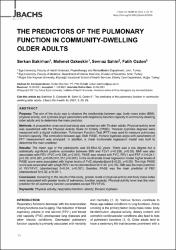| dc.contributor.author | Bakırhan, Serkan | |
| dc.contributor.author | Özkeskin, Mehmet | |
| dc.contributor.author | Şahin, Sevnaz | |
| dc.contributor.author | Özden, Fatih | |
| dc.date.accessioned | 2021-11-25T11:25:35Z | |
| dc.date.available | 2021-11-25T11:25:35Z | |
| dc.date.issued | 2021 | en_US |
| dc.identifier.citation | Bakırhan, S. , Özkeskin, M. , Şahin, S. , Özden, F. "The predictors of the pulmonary function in community-dwelling older adults" . Journal of Basic and Clinical Health Sciences 5 (2021 ): 23-29 <https://dergipark.org.tr/en/pub/jbachs/issue/64953/879109> | en_US |
| dc.identifier.issn | 2458-8938 | |
| dc.identifier.issn | 2564-7288 | |
| dc.identifier.uri | https://doi.org/10.30621/jbachs.879109 | |
| dc.identifier.uri | https://hdl.handle.net/20.500.12809/9659 | |
| dc.description.abstract | Purpose: The aim of the study was to observe the relationship between age, body mass index (BMI), physical activity, and kyphosis angle parameters with respiratory function capacity in community-dwelling older adults and to determine the main predictor.
Methods: A prospective cross-sectional study was carried out with 70 older adults. Physical activity level was questioned with the Physical Activity Scale for Elderly (PASE). Thoracic kyphosis degrees were measured with a digital inclinometer. Pulmonary Function Test (PFT) was used to measure pulmonary function capacity. The correlation between age, BMI, PASE, thoracic kyphosis angle with parameters of PFT measurement was analyzed. In addition, a linear multivariate regression model was built to determine the main predictor.
Results: The mean age of the participants was 69.88 +/- 4.52 years. There was a low degree but a statistically significant positive correlation between BMI and FEV1 (r=0.258, p<0.05). BMI was also associated with FEV1/FVC (r=0.338, p<0.001). PASE was related with FVC, FEV1 and PEF (r1=0.241, p<0.05; r2=0.281, p<0.05;r3=0.317,p<0.001). In the multivariate linear regression model, higher levels of PASE score were associated with higher levels of FVC (standardized 11=0.25, p<0.05). The high PASE score was associated with a high FEV1 score (standardized 11=0.30, p<0.05). BMI was the main predictor of FEV1/FVC (standardized 11=0.34, p<0.001). Besides, PASE was the main predictor of PEF (standardized 11=0.32, p<0.001).
Conclusion: According to the results of the study, greater levels of physical activity and body mass index were associated with greater levels of pulmonary function capacity. Physical activity level was the main predictor for all pulmonary function parameters except FEV1/FVC | en_US |
| dc.item-language.iso | eng | en_US |
| dc.publisher | DOKUZ EYLUL UNIV INST HEALTH SCIENCES | en_US |
| dc.relation.isversionof | 10.30621/jbachs.879109 | en_US |
| dc.item-rights | info:eu-repo/semantics/openAccess | en_US |
| dc.subject | Physical activity | en_US |
| dc.subject | Respiratory function | en_US |
| dc.subject | Elderly | en_US |
| dc.subject | Thoracic kyphosis | en_US |
| dc.title | THE PREDICTORS OF THE PULMONARY FUNCTION IN COMMUNITY-DWELLING OLDER ADULTS | en_US |
| dc.item-type | article | en_US |
| dc.contributor.department | MÜ, Köyceğiz Sağlık Hizmetleri Meslek Yüksekokulu, Sağlık Bakım Hizmetleri Bölümü | en_US |
| dc.contributor.authorID | 0000-0001-7292-6273 | en_US |
| dc.contributor.institutionauthor | Özden, Fatih | |
| dc.identifier.volume | 5 | en_US |
| dc.identifier.issue | 3 | en_US |
| dc.identifier.startpage | 23 | en_US |
| dc.identifier.endpage | 29 | en_US |
| dc.relation.journal | JOURNAL OF BASIC AND CLINICAL HEALTH SCIENCES | en_US |
| dc.relation.publicationcategory | Makale - Uluslararası Hakemli Dergi - Kurum Öğretim Elemanı | en_US |


















